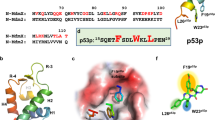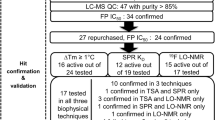Abstract
Based on the perturbation of its expression in human cancers and on its involvement in transformation and tumorigenesis, protein kinase CK2 has recently attracted attention as a potential therapeutic target. To assess the value of CK2 as a target for antiproliferative strategies, we have initiated a program aiming to develop inhibitors targeting specifically the regulatory CK2β subunit. Here, we use a two-hybrid approach to isolate from combinatorial libraries, peptide aptamers that specifically interact with CK2β. One of these (P1), which has significant sequence homology to the cytomegalovirus IE2 protein, binds with high affinity to the N-terminal domain of CK2β without disrupting the formation of the CK2 holoenzyme. Expression of green fluorescent protein (GFP)-P1 in different mammalian cell lines activates p53 phosphorylation on serine 15, induces an upregulation of p21 and the release of the Cyt-C and apoptosis-inducing factor proapoptotic proteins triggering caspase-dependent and caspase-independent apoptosis. GFP-P1-induced apoptosis is associated with a p53-dependent pathway as cell death was abrogated in p53 knocked out cells. In summary, our data show that genetically selected peptide aptamers that specifically target CK2β can induce apoptosis in mammalian cells through the recruitment of a p53-dependent apoptosis pathway. They also emphasize the critical role of CK2β for cell survival and might allow the design of novel proapoptotic agents targeting this protein.
This is a preview of subscription content, access via your institution
Access options
Subscribe to this journal
Receive 50 print issues and online access
$259.00 per year
only $5.18 per issue
Buy this article
- Purchase on Springer Link
- Instant access to full article PDF
Prices may be subject to local taxes which are calculated during checkout






Similar content being viewed by others
Accession codes
References
Abraham MC, Shaham S . (2004). Trends Cell Biol 14: 184–193.
Ahmed K, Gerber DA, Cochet C . (2002). Trends Cell Biol 12: 226–230.
Andreau K, Castedo M, Perfettini JL, Roumier T, Pichard E, Souquer S et al. (2004). J Biol Chem 279: 55937–55945.
Bibby AC, Litchfield DW . (2005). Int J Biol Sci 1: 67–79.
Bjorling-Poulsen M, Siehler S, Wiesmuller L, Meek D, Niefind K, Issinger OG . (2005). Oncogene 24: 6194–6200.
Blaydes JP, Hupp TR . (1998). Oncogene 17: 1045–1052.
Buchou T, Vernet M, Blond O, Jensen HH, Pointu H, Olsen BB et al. (2003). Mol Cell Biol 23: 908–915.
Castedo M, Ferri KF, Blanco J, Roumier T, Larochette N, Barretina J et al. (2001). J Exp Med 194: 1097–1110.
Chantalat L, Leroy D, Filhol O, Nueda A, Benitez MJ, Chambaz EM et al. (1999). EMBO J 18: 2930–2940.
Chiou SH, Liu JH, Hsu WM, Chen SS, Chang SY, Juan LJ et al. (2001). J Immunol 167: 4098–4103.
Colas P, Cohen B, Jessen T, Grishina I, McCoy J, Brent R . (1996). Nature 380: 548–550.
Colman-Lerner A, Chin TE, Brent R . (2001). Cell 107: 739–750.
Dagher MC, Filhol-Cochet O . (1997). Biotechniques 22: 916–918, 920–922.
Dobrowolska G, Meggio F, Szczegielniak J, Muszynska G, Pinna LA . (1992). Eur J Biochem 204: 299–303.
el-Deiry WS, Tokino T, Velculescu VE, Levy DB, Parson R, Trent JM et al. (1993). Cell 75: 817–825.
Estojak J, Brent R, Golemis EA . (1995). Mol Cell Biol 15: 5820–5829.
Fabbrizio E, Le Cam L, Polanowska J, Kaczorek M, Lamb N, Brent R et al. (1999). Oncogene 18: 4357–4363.
Ferri KF, Kroemer G . (2000). Nat Cell Biol 2: E63–E64.
Filhol O, Cochet C, Wedegaertner P, Gill GN, Chambaz EM . (1991). Biochemistry 30: 11133–11140.
Filhol O, Martiel JL, Cochet C . (2004). EMBO Rep 5: 351–355.
Filhol O, Nueda A, Martel V, Gerber-Scokaert D, Benitez MJ, Souchier C et al. (2003). Mol Cell Biol 23: 975–987.
Fraser AG, Kamath RS, Zipperlen P, Martinez-Campos M, Sohrmann M, Ahringer J . (2000). Nature 408: 325–330.
Geyer CR, Brent R . (2000). Methods Enzymol 328: 171–208.
Ghavidel A, Schultz MC . (2001). Cell 106: 575–584.
Golemis EA, Brent R . (1992). Mol Cell Biol 12: 3006–3014.
Grein S, Raymond K, Cochet C, Pyerin W, Chambaz EM, Filhol O . (1999). Mol Cell Biochem 191: 105–109.
Guerra B, Boldyreff B, Sarno S, Cesaro L, Issinger OG, Pinna LA . (1999a). Pharmacol Ther 82: 303–313.
Guerra B, Issinger OG . (1999). Electrophoresis 20: 391–408.
Guerra B, Issinger OG, Wang JY . (2003). Oncogene 22: 4933–4942.
Guerra B, Siemer S, Boldyreff B, Issinger OG . (1999b). FEBS Lett 462: 353–357.
Heriche JK, Lebrin F, Rabilloud T, Leroy D, Chambaz EM, Goldberg Y . (1997). Science 276: 952–955.
Hopkins AL, Groom CR . (2002). Nat Rev Drug Discov 1: 727–730.
Joza N, Susin SA, Daugas E, Stanford WL, Cho SK, Li CY et al. (2001). Nature 410: 549–554.
Keller DM, Zeng X, Wang Y, Zhang QH, Kapoor M, Shu H et al. (2001). Mol Cell 7: 283–292.
Ladbury JE, Lemmon MA, Zhou M, Green J, Botfield MC, Schlessinger J . (1995). Proc Natl Acad Sci USA 92: 3199–3203.
Leroy D, Filhol O, Quintaine N, Sarrouilhe D, Loue-Mackenbach P, Chambaz EM et al. (1999). Mol Cell Biochem 191: 43–50.
Litchfield DW . (2003). Biochem J 369: 1–15.
Loizou JI, El-Khamisy SF, Zlatanou A, Moore DJ, Chan DW, Qin J et al. (2004). Cell 117: 17–28.
Lowe SW, Sherr CJ . (2003). Curr Opin Genet Dev 13: 77–83.
Luo H, Chan DW, Yang T, Rodriguez M, Chen BP, Leng M et al. (2004). Mol Cell Biol 19: 8356–8365.
Maizel A, Tassetto M, Filhol O, Cochet C, Prochiantz A, Joliot A . (2002). Development 129: 3545–3553.
Martel V, Filhol O, Nueda A, Cochet C . (2002). Ann NY Acad Sci 973: 272–277.
Messerle M, Keil GM, Koszinowski UH . (1991). J Virol 65: 1638–1643.
Niefind K, Guerra B, Ermakowa I, Issinger OG . (2001). EMBO J 20: 5320–5331.
Pinna LA . (2002). J Cell Sci 115: 3873–3878.
Pinna LA, Meggio F . (1997). Prog Cell Cycle Res 3: 77.s–97.s.
Rich T, Allen RL, Wyllie AH . (2000). Nature 407: 777–783.
Ruzzene M, Penzo D, Pinna LA . (2002). Biochem J 364: 41–47.
Shimada K, Kondo K, Yamanishi K . (2004). Microbiol Immunol 48: 205–210.
Stalter G, Siemer S, Becht E, Ziegler M, Remberger K, Issinger OG . (1994). Biochem Biophys Res Commun 202: 141–147.
Stigare J, Buddelmeijer N, Pigon A, Egyhazi E . (1993). Mol Cell Biochem 129: 77–85.
Susin SA, Lorenzo HK, Zamzami N, Marzo I, Snow BE, Brothers GM et al. (1999). Nature 397: 441–446.
Theis-Febvre N, Filhol O, Froment C, Cazales M, Cochet C, Monsarrat B et al. (2003). Oncogene 22: 220–232.
Unger GM, Davis AT, Slaton JW, Ahmed K . (2004). Curr Cancer Drug Targets 4: 77–84.
Vogelstein B, Lane D, Levine AJ . (2000). Nature 408: 307–310.
Wadd S, Bryant H, Filhol O, Scott JE, Hsieh TY, Everett RD et al. (1999). J Biol Chem 274: 28991–28998.
Wiebusch L, Hagemeier C . (2001). EMBO J 20: 1086–1098.
Wyllie AH . (1980). Nature 284: 555–556.
Zamzami N, Susin SA, Marchetti P, Hirsch T, Gomez-Monterrey I, Castedo M et al. (1996). J Exp Med 183: 1533–1544.
Zhou MM, Harlan JE, Wade WS, Crosby S, Ravichandran KS, Burakoff SJ et al. (1995). J Biol Chem 270: 31119–31123.
Acknowledgements
We thank Dr B Ducommun and Dr A Joliot for their generous gift of recombinant Cdc25B and Engrailed proteins, respectively, and B Vogelstein for the WT and p53-null HCT116 cells. Work on CK2 in our group is supported by grants 2004 from the Ligue National contre le Cancer (équipe labellisée), the Institut National de la Santé and the Commissariat à l'Energie Atomique. VM was supported by the Association pour la Recherche sur le Cancer (ARC).
Author information
Authors and Affiliations
Corresponding author
Additional information
Supplementary Information accompanies the paper on Oncogene website (http://www.nature.com/onc).
Supplementary information
Rights and permissions
About this article
Cite this article
Martel, V., Filhol, O., Colas, P. et al. p53-dependent inhibition of mammalian cell survival by a genetically selected peptide aptamer that targets the regulatory subunit of protein kinase CK2. Oncogene 25, 7343–7353 (2006). https://doi.org/10.1038/sj.onc.1209722
Received:
Revised:
Accepted:
Published:
Issue Date:
DOI: https://doi.org/10.1038/sj.onc.1209722
Keywords
This article is cited by
-
Protein kinase CK2 in breast cancer: the CK2β regulatory subunit takes center stage in epithelial plasticity
Cellular and Molecular Life Sciences (2015)



